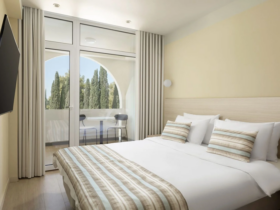Despite the existence of various styles of the design of the modern interior, in most cases they are united by one general factor — the desire for the maximum environmental friendliness of the materials used. Therefore, in recent years, cork wallpaper has been in increasing demand — natural material used in wall decoration.
What is cork wallpaper?
There are several types of this finishing material. The most expensive of them are the so -called cork panels, which are 3 mm plates in size 0.3×0.6 meters. The lower layer of the panels is a pressed cork, the upper is the thin veneer of the cork tree saturated with wax. Thanks to such protection, this wall covering can be used in bathrooms.
Slightly less expensive type of such wall covering — cork rolls. Their structure is the same as that of a more expensive fellow, but not all of them have additional wax impregnation. Of all three types of cork finishing materials, rolls have the largest number of textures and colors — can be painted both the lower layer (pressed cork chips) and the upper (veneer), in addition, both layers can be painted or unpainted. The size of the roll, the thickness of which is 2 mm — 10×0.5 meters.
The third, the most popular and cheap of cork coatings — wallpaper. The basis for them is a paper with a 1-mm layer of veneer. Wallpaper can be both natural and painted. Sold in rolls size 10×0.5 meters.
Advantages of cork coatings and their properties
One of the main advantages of cork wallpaper and other coatings from the same material is their natural origin and, as a result, the absence of harmful substances in their composition. In addition, among the advantages of this finishing material, the density of which is comparable to the density of heavy vinyl wallpaper, we can note:
resistance to various mechanical damage;
high level of noise absorption (both outside and from the inside of the room);
the ability to push dust and dirt;
non -combustibility;
the ability to combine several colors and textures in one room;
Moistenous properties.
In addition, the cork coating contributes to the creation of a favorable microclimate in the room — in winter it serves as an additional insulation, and in the summer it allows you to maintain coolness. Care for cork wallpaper, panels and rolls is simple: they can be wiped with a damp sponge, cleaned with a vacuum cleaner, and the stains that have come are easily removed with sandpaper with fine grain.
Cork wallpapers, panels, rolls: how to glue
One of the most important conditions when sticking a cork coating is a well -prepared dry surface, cleansed of the remains of previous finishing materials. In the event that the wall has a significant curvature, it is recommended to leve it with plaster or putty. In addition, the wall is recommended to be treated with a primer.
Camping wallpapers are easily glued. Since they have a paper base, the same glue is used for the sticker as when working with vinyl wallpaper. Glue can be applied both to wallpaper and on the wall — in most cases this is indicated by the manufacturer of wall coatings. Wallpaper is glued, excesses are removed with scissors. There are also self -adhesive cork wallpapers, which can be glued to the wall by removing the protective film from the back of the roll.
Before proceeding with the sticker of rolls or panels, you should remove them from the package and leave for two days in the room where they will be glued. This will enable the material to adapt to the microclimate of the room. After applying the glue to both surfaces, you should wait 20 minutes.
Camping rolls are glued to the wall using a special glue for a cork, which is applied to both the wall and on the cork coating, while you need to maintain the edges of the glued segment especially carefully. It is recommended to cut pieces to the desired size in advance, measuring the height of the room and adding about 5 cm. The coating should be tightly pressed against the wall and roll with a rubber roller for airboring air bubbles.
Before gluing the plates, marking on the wall should be made, having a vertical line in its center using a special plumb line. Since the plates always have a slightly different color and can differ in size, it is recommended to lay out on the floor before laying on the walls in the order in which they are planned to glue. At the beginning of the work, the glue must be applied on an area of 1 m2 on both sides of the line drawn. The first tile is glued to the wall so that its central line coincides with the central line of the wall. Further, the sticker is carried out on both sides of the first plate.
Camping wall coatings are very durable — with the right sticker and care, they will retain all their properties for two decades.













Оставить коммент.